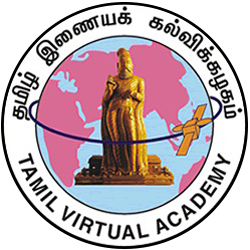P10346 Paaventhar Pillai Tamil
This
lesson offers an insight into a popular minor literary genre called
‘Pillai Tamil’. It explains the characteristic features of this
literary form through a renowned Pillai Tamil text called ‘Paaventhar
Pillai Tamil’. Sittrilakkiyam or minor literary genres flourished
in Tamil Nadu during the reign of the Nayakkars which dates from
1350 A.D. to 1750 A.D. There are 96 minor literary forms in Tamil.
The poet-saint Periyalwar is considered to be the forerunner of
Pillai Tamil Ilakkiyam. He imagined Lord Krishna as a small child
and composed several hymns in the form of lullabies for the Lord.
These were called ‘Pillai Paatu’ or ‘Pillai Kavi’. ‘Kulothungan
Pillai Tamil’ written by Ottakkoothar in the 12th century A.D. is
regarded as the first Pillai Tamil text in Tamil. In this work Ottakkoothar
traces the glorious history of the Chola dynasty while portraying
the childhood of King Kulothungan. ‘Meenatchi Amman Pillai Tamil’
and ‘Muthakumaraswamy Pillai Tamil’ are two of the most popular
Pillai Tamil texts.
In Pillai Tamil the poet imagines his protagonist,
who may be a God, a king, a saint, a great hero or a renowned personality
to be a child and sings in praise of him or her. The poet takes
on the role of a loving mother and traces the different stages in
the protagonists’ childhood with great affection. 10 stages beginning
from the child’s 3rd month are portrayed. Every stage has 10 verses.
Thus there are a total of 100 verses. Pillai Tamil is classified
into ‘Aanpaal Pillai Tamil’ and ‘Pen Paal Pillai Tamil’ on the basis
of gender. The first 7 stages are the same for both the baby boy
and girl but the last three stages are different. The lesson lists
and explains the 10 stages.
Written by Pulamaipithan, ‘Paaventhar Pillai
Tamil’ celebrates the greatness of the famous Tamil Poet Barathidasan.
Pulamaipithan is a contemporary poet of great repute. His poems
are noted for their profound ideas and imaginative beauty. Pulamaipithan
wrote ‘Paaventhar Pillai Tamil’ in praise of Barathidasan’s contributions
to the Tamil language. Hailed as a revolutionary poet, Barathidasan
had a deep impact on Tamil literature in the early 20th century.
Unlike other traditional Pillai Tamil texts, Pulamaipithan does
not stop with a description of the 10 stages of his protagonist’s
childhood. He uses the conventions of this form of poetry to trace
the growth of the Dravidian movement in Tamil Nadu beginning from
Periyar. He explores the political ideologies of Periyar and Aringar
Anna. He commends Barathidasan’s contributions as a great literary
figure and committed social worker. It has 101 verses and the first
verse is dedicated to Aringar Anna.
‘Paaventhar Pillai Tamil’ is rich in terms
of style as well as content. Pulamaipithan’s verses have the same
rhythmic intensity and imaginative depth that are characteristic
of Barathidasan’s poetry.


